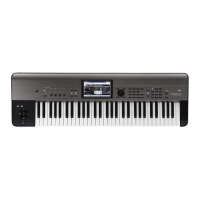PROG P4: Amp/EQ 4–1: Amp1/Driver1
35
PROG P4: Amp/EQ
Oscillators 1 and 2 have separate controls for volume (also
called “amplitude,” or “amp” for short); pan; and Drive; as
well as dedicated amp envelopes and keyboard tracking
generators. Additionally, both Oscillators share a three‐band
EQ.
These pages let you control all of these related parameters.
Among other things, you can:
• Set up the Driver circuit, which adds saturation and bass
boost to the timbre.
• Set the pan position and pan modulation.
• Control amp level and modulation, including keyboard
tracking, the amp envelope, LFO modulation, and AMS
control.
• Set up the three‐band Track EQ.
Note that when the Oscillator Mode is set to Single, only
Oscillator 1’s amp, pan, and drive parameters are active; the
pages for Oscillator 2 will be grayed out.
4–1: Amp1/Driver1
This page controls the basic settings for the Amp/EQ section.
Here, you can:
• Set up the Driver circuit.
• Set the initial volume level.
• Control the pan position and pan modulation.
4–1a: Driver
The Driver adds saturation and overdrive to the sound, for
everything from subtle fattening to drastic distortion. Unlike
an overdrive effect, the Driver processes each voice
individually, so the timbre stays the same regardless of how
many voices are being played.
The two main parameters, Drive and Low Boost, work
together to create the overall Driver effect. Drive contributes
edge and bite, and Low Boost provides the body as well as
boosting the bass.
Bypass [Off, On]
On (checked): the Driver is completely removed from the
signal path.
Drive [00...99]
This controls the amount of edge and bite in the timbre. Low
settings will produce mild saturation, and higher settings
create more obvious distortion.
Often, it’s useful to increase the Low Boost along with the
Drive.
Note: Even when the Drive amount is set to 0, the Driver
circuit still affects the timbre. If your goal is a completely
pristine sound, use the Bypass control instead.
AMS (Drive) [List of AMS Sources]
This selects an AMS modulation source to control the Drive
amount.
For a list of AMS sources, please see “AMS (Alternate
Modulation Source) List” on page 340.
Intensity [–99...+99]
This controls the depth and direction of the AMS
modulation for Drive.
Low Boost [00...99]
This low‐frequency EQ controls the body character of the
sound. The specific EQ frequencies affected will change
with the Drive setting.
Higher amounts increase the bass boost, and will also
intensify the effect of the Drive parameter.
AMS [List of AMS Sources]
This selects an AMS modulation source to control the Low
Boost amount.
For a list of AMS sources, please see “AMS (Alternate
Modulation Source) List” on page 340.
Intensity [–99...+99]
This controls the depth and direction of the AMS
modulation for Low Boost.
4–1b: Amp Level
Amp Level [000...127]
This controls the basic volume level of Oscillator 1, before
keyboard tracking, velocity, and other modulation.
Mixer, DrumTrack and volume
You can control the Oscillator volume directly from the
sliders in the 0–3 Mixer & Dram Track page. This is a
separate parameter, in addition to Amp Level.
MIDI and volume
You can control the Program’s overall volume via MIDI
using both Volume (CC#7) and Expression (CC#11).
When used one at a time, the two controllers work in
exactly the same way: a MIDI value of 127 is equal to
the Amp Level setting, and lower values reduce the
volume.
If both CC#7 and CC#11 are used simultaneously, the
one with the lower value determines the maximum
volume, and the one with the higher value scales down
from that maximum.
This is controlled on the global MIDI channel (Global 1–1a).

